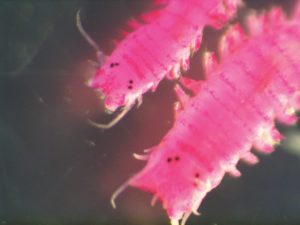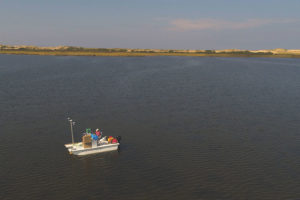TRURO — Recent research at the Center for Coastal Studies in Provincetown has documented the current state of East Harbor’s benthic communities — species that live in the sediments on the lagoon floor. To their surprise, scientists discovered these organisms are thriving far away from the culvert that allows seawater to enter the lagoon. That’s the good news.
There are reasons to do more in the nearly 20-year-old restoration effort, according to Mark Adams, a coastal geoscientist with the Cape Cod National Seashore. That is, if one goal of tidal restoration is to buffer the Outer Cape from storm surges as sea levels rise.
“The classic example is New Orleans,” Adams explained. “Salt marshes serve as a buffer around estuaries. They slow down wave energy. With those marshes lost in the Mississippi Delta, the levees could not stand up to the direct hit of flood water.”
But the scientists are undecided about whether more restoration — further increasing the tidal flow — is necessarily a good idea. Cost and complexity are the disincentives.

What’s Good for Worms
Center for Coastal Studies scientists and study co-authors Agnes Mittermayr and Mark Borrelli explained that the fineness of sediment is more important to bottom-dwelling critters than proximity to the source of tidal flow in the system. Their analysis showed that sediment grain size could explain 84 percent of species distribution in East Harbor.
When an ecosystem is first opened up to tidal flow — by building a culvert to the ocean, for example — saltwater organisms are able to access new habitat beyond the culvert. At first, their range is constrained by salinity, acidity, and other factors that slowly morph as saltwater infiltrates the system. With time, as the habitat improves for ocean organisms, they can live farther away from the culvert.
That’s just what has happened in East Harbor. “We don’t see any difference between areas close to and far away from the culvert in terms of species diversity,” Mittermayr said.

The team looked for tiny invertebrates, like worms and mollusks, living in sediment samples collected from 16 sites around the lagoon and was surprised to find that the number and diversity of these animals had increased dramatically. For example, in a 2011 study, just 7 species of mollusk were identified in East Harbor. In contrast, 24 species were identified in Mittermayr’s and Borrelli’s recent study.
Mollusks and other invertebrates living in the surface sediments are a boon to the entire ecosystem. Although perhaps underappreciated by wildlife enthusiasts, these tiny creatures are the basis of the food web, feeding fish and birds, Mittermayr said.
The scientists were also surprised to find eel grass, important for the ecosystem, growing in East Harbor. “Eel grass is incredibly valuable habitat,” Borrelli said. With hiding spots for small fish, “life flocks to it,” he added.
Sea grass is an indicator species that suggests good water quality. If water contains more than 0.35 micrograms of nitrogen per liter, eel grass cannot grow, implying that East Harbor’s water is very low in nitrogen, Mittermayr said.
Action and Impact
East Harbor, also called Pilgrim Lake, is a 346-acre back barrier tidal lagoon that was isolated from the ocean for over 100 years. In 1868 a 1,000-foot inlet to the northwest was filled in to make way for the railroad, isolating the estuary from any saltwater flow. The lagoon became anoxic (oxygen-deprived), with noxious odors and midges making the area unpleasant for human visitors.
After a massive fish kill in 2002, a culvert was opened to allow two-way flow between the estuary and Cape Cod Bay. Since then, the system has shown remarkable improvement as the water became more oxygenated and saltwater species moved in.
But in recent years, the estuary has received less tidal flow due to the failure in 2016 of the culvert between Cape Cod Bay and Moon Pond, a small pond connecting the bay to East Harbor.
According to town documents, the town decided to repair the culvert in two phases, the first of which would address the seaward section of the pipe between Shore Road and Cape Cod Bay, which was slumping and affected by multiple sinkholes. At the annual Truro town meeting in 2017, voters agreed to borrow $3.7 million for the project.
Dept. of Public Works Director Jarrod Cabral wrote in an email to the Independent that Phase I of the culvert project was completed in spring 2019. The repair restored the culvert’s original dimensions of 48 inches by 72 inches. The second section, between Shore Road and Route 6, is still in the permitting process to be removed and replaced, Cabral wrote.
Mittermayr and Borrelli said that East Harbor’s quick rejuvenation is likely due to the fact that it is an undeveloped area.
Looking for a Buffer
Is the progress so far enough? Not if you’re a fish, according to Mittermayr. “If you’re a fish or looking for new habitat, East Harbor could benefit from more tidal flow.” The tidal flushing would mean more oxygen exchange and would help maintain the salinity level in the lagoon after rains, helping saltwater organisms thrive.
As for humans interested in enlisting the marsh in climate adaptation, Seashore ecologist Stephen Smith said that East Harbor’s tidal range is still too constricted for saltwater to reach the marsh platform. And because salinity dictates where salt marsh vegetation can grow, the lagoon is still dominated by freshwater plants, like phragmites and cattail, which offer fewer protective benefits.
“Currently, there’s a fringe of salt marsh flora,” said Smith. “If we get more water in the system, that stuff will be able to spread.” But bringing in more of the tide would require quite a big opening at the culvert, Smith said.
More tidal flow might affect surrounding structures. Specifically, if a tidal flow of several feet were introduced, Borelli predicts there would be problems with Route 6A. “There’s always a trade off with restoration — how much benefit you’ll get with increased tidal range,” he said. “You start to reach the point of diminishing returns.”
To understand the potential benefits would require consideration of bigger scale threats and benefits.
National Seashore Supt. Brian Carlstrom told the Independent that the park is working with the town to maximize flow to the system.
“The value of tidal estuaries is immense,” Carlstrom said. “We’re continually looking at areas where we can improve them. It’s part of our mission, and we try wherever we have the possibility to restore them.”
“It’s an ecosystem, and we’re part of the ecosystem,” Borrelli said. “If it’s healthy, then we benefit too.”
